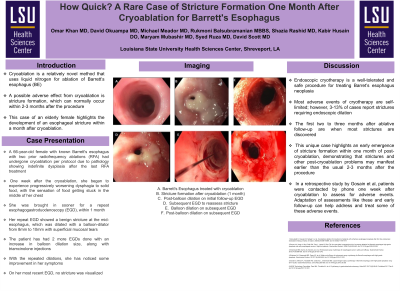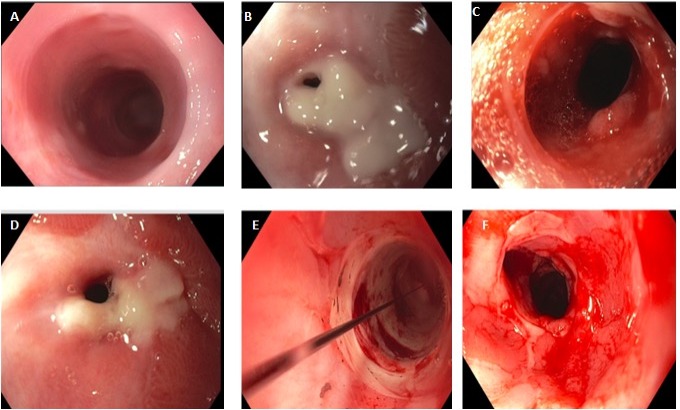Tuesday Poster Session
Category: Esophagus
P3330 - How Quick? A Rare Case of Stricture Formation One Month After Cryoablation for Barrett's Esophagus
Tuesday, October 24, 2023
10:30 AM - 4:00 PM PT
Location: Exhibit Hall

Has Audio
- OK
Omar Khan, MD
LSU Health Sciences Center
Shreveport, LA
Presenting Author(s)
Omar Khan, MD1, David Okuampa, MD1, Michael Meador, MD1, Rukmoni Balasubramanian, MBBS2, Shazia Rashid, MD1, Kabir Husain, DO1, Maryam Mubashir, MD1, Syed Musa Raza, MD1, David Scott, MD1
1LSU Health Sciences Center, Shreveport, LA; 2University of Florida Jacksonville, Jacksonville, FL
Introduction: Cryoablation is a relatively novel method that uses liquid nitrogen for ablation of Barrett’s esophagus (BE). A possible adverse effect from cryoablation is stricture formation, which can normally occur within 2-3 months after the procedure. This case of an elderly female highlights the development of an esophageal stricture within a month after cryoablation.
Case Description/Methods: A 66-year-old female with known Barrett's esophagus with two prior radiofrequency ablations (RFA) had undergone cryoablation per protocol due to pathology showing indefinite dysplasia after the last RFA treatment. One week after the cryoablation, she began to experience progressively worsening dysphagia to solid food, with the sensation of food getting stuck in the middle of her chest. She was brought in sooner for a repeat esophagogastroduodenoscopy (EGD), within 1 month. Her repeat EGD showed a benign stricture at the mid-esophagus, which was dilated with a balloon-dilator from 8mm to 10mm with superficial mucosal tears. The patient has had 2 more EGDs done with an increase in balloon dilation size, along with triamcinolone injections. With the repeated dilations, she has noticed some improvement in her symptoms and is scheduled for a repeat EGD.
Discussion: Endoscopic cryotherapy is a well-tolerated and safe procedure for treating Barret’s esophagus neoplasia. Most adverse events of cryotherapy are self-limited; however, 3-13% of cases report strictures requiring endoscopic dilation. The first two to three months after ablative follow-up are when most strictures are discovered. This unique case highlights an early emergence of stricture formation within one month of post-cryoablation, demonstrating that strictures and other post-cryoablation problems may manifest earlier than the usual 2-3 months after the procedure. In a retrospective study by Gosain et al, patients were contacted by phone one week after cryoablation to assess for adverse events. Adaptation of assessments like these and early follow-up can help address and treat some of these adverse events.

Disclosures:
Omar Khan, MD1, David Okuampa, MD1, Michael Meador, MD1, Rukmoni Balasubramanian, MBBS2, Shazia Rashid, MD1, Kabir Husain, DO1, Maryam Mubashir, MD1, Syed Musa Raza, MD1, David Scott, MD1. P3330 - How Quick? A Rare Case of Stricture Formation One Month After Cryoablation for Barrett's Esophagus, ACG 2023 Annual Scientific Meeting Abstracts. Vancouver, BC, Canada: American College of Gastroenterology.
1LSU Health Sciences Center, Shreveport, LA; 2University of Florida Jacksonville, Jacksonville, FL
Introduction: Cryoablation is a relatively novel method that uses liquid nitrogen for ablation of Barrett’s esophagus (BE). A possible adverse effect from cryoablation is stricture formation, which can normally occur within 2-3 months after the procedure. This case of an elderly female highlights the development of an esophageal stricture within a month after cryoablation.
Case Description/Methods: A 66-year-old female with known Barrett's esophagus with two prior radiofrequency ablations (RFA) had undergone cryoablation per protocol due to pathology showing indefinite dysplasia after the last RFA treatment. One week after the cryoablation, she began to experience progressively worsening dysphagia to solid food, with the sensation of food getting stuck in the middle of her chest. She was brought in sooner for a repeat esophagogastroduodenoscopy (EGD), within 1 month. Her repeat EGD showed a benign stricture at the mid-esophagus, which was dilated with a balloon-dilator from 8mm to 10mm with superficial mucosal tears. The patient has had 2 more EGDs done with an increase in balloon dilation size, along with triamcinolone injections. With the repeated dilations, she has noticed some improvement in her symptoms and is scheduled for a repeat EGD.
Discussion: Endoscopic cryotherapy is a well-tolerated and safe procedure for treating Barret’s esophagus neoplasia. Most adverse events of cryotherapy are self-limited; however, 3-13% of cases report strictures requiring endoscopic dilation. The first two to three months after ablative follow-up are when most strictures are discovered. This unique case highlights an early emergence of stricture formation within one month of post-cryoablation, demonstrating that strictures and other post-cryoablation problems may manifest earlier than the usual 2-3 months after the procedure. In a retrospective study by Gosain et al, patients were contacted by phone one week after cryoablation to assess for adverse events. Adaptation of assessments like these and early follow-up can help address and treat some of these adverse events.

Figure: A. Barrett's Esophagus treated with cryoablation
B. Stricture formation after cryoablation (1 month)
C. Post-balloon dilation on initial follow-up EGD
D. Subsequent EGD to reassess stricture
E. Balloon dilation on subsequent EGD
F. Post-balloon dilation on subsequent EGD
B. Stricture formation after cryoablation (1 month)
C. Post-balloon dilation on initial follow-up EGD
D. Subsequent EGD to reassess stricture
E. Balloon dilation on subsequent EGD
F. Post-balloon dilation on subsequent EGD
Disclosures:
Omar Khan indicated no relevant financial relationships.
David Okuampa indicated no relevant financial relationships.
Michael Meador indicated no relevant financial relationships.
Rukmoni Balasubramanian indicated no relevant financial relationships.
Shazia Rashid indicated no relevant financial relationships.
Kabir Husain indicated no relevant financial relationships.
Maryam Mubashir indicated no relevant financial relationships.
Syed Musa Raza indicated no relevant financial relationships.
David Scott indicated no relevant financial relationships.
Omar Khan, MD1, David Okuampa, MD1, Michael Meador, MD1, Rukmoni Balasubramanian, MBBS2, Shazia Rashid, MD1, Kabir Husain, DO1, Maryam Mubashir, MD1, Syed Musa Raza, MD1, David Scott, MD1. P3330 - How Quick? A Rare Case of Stricture Formation One Month After Cryoablation for Barrett's Esophagus, ACG 2023 Annual Scientific Meeting Abstracts. Vancouver, BC, Canada: American College of Gastroenterology.
